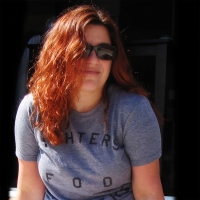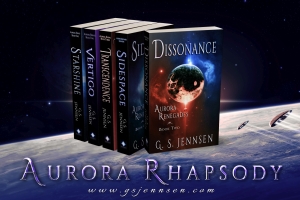Introduction by Tommy Muncie
G S Jennsen is an author who knows how to write about the impossible. Over the last couple of months, she’s received quite a number of ‘How do you do this?’ messages from my Twitter account. How do you get rid of a pestering author who likes to read about the tricks of the trade? Write them a craft essay, of course, and post it on their blog. That oughta shut ’em up.
You don’t have to have read any of G.S Jennsen’s books to follow this post (although I do recommend them) – it’s a guideline for both aspiring writers and experienced ones looking to refine their approach to tech-building. We all know about world building, right? So what do the people in your world come up with when they hit the workshops, and how does it serve your story?
Enough from me. My guest can answer all that…
Creating Exciting Future Space Technology While Not Failing Science 101
Unless you’re writing very near-future science fiction, chances are you’re going to have to invent technology that doesn’t currently exist. The further out you set your story, the less you can rely on easy extrapolations from current technology. The good news is, this frees you from the limitations of current technology. The bad news is, you have to figure out your own rules and limitations.
Before You Begin: Deciding How Hard Your Science Will Be
One of the most important things you need to know is how technology will be presented in your story. If you’re writing soft sci-fi/space fantasy, you can more or less just give all the cool toys your characters use fancy names and be done with it (see The Fifth Element, with its ‘phonic detector’ and ‘neurocharged’ assault guns). If you’re writing hard military sci-fi, you’ll need to construct a very detailed set of terms, components, explanations and probably schematics. There’s a lot of room between those two extremes, so decide where you fit on the spectrum.
My series, Aurora Rhapsody, is set 300 years in the future. We’ve developed FTL engines, extensive cybernetics and AI. The series is space opera, not hard sci-fi, but all the technology is at a minimum based on plausible extensions of current scientific knowledge or theory.
I spent a month researching and ‘setting’ the technology, history/timeline and other elements of the world before I ever wrote a word. I started with the basic assumption that between now and then we would have solved a lot of the scientific mysteries we’re trying to understand now, such as quantum physics. The tools necessary for practical, regular space travel would have been invented: artificial gravity plates, effective radiation shielding and so on.
I needed fast travel between star systems; I chose to base my FTL engines on the Alcubierre drive concept, and sub-light impulse drives on an implementation of the Woodward-Mach effect. I needed the characters to be able to talk to each other from across the galaxy; a mastery of quantum physics and computing made this an easy one, since quantum particle interactions aren’t limited by distance.
The Science (Fiction) Should Serve the Story
When working out the details of your tech, always keep in mind that it is there to serve your story, not the other way around. Writing space opera, for instance, means the tech needs to be impressive, occasionally flashy and helpful in allowing the characters to do amazing things. This is quite different to hard sci-fi, where often much of the plot revolves around the struggle by the characters to make the tech work for them, or even keep them alive.
Most of that research I did was for me, not the reader. One of the keys to creating immersive sci-fi is this: don’t write from the mindset of someone living today, but rather the mindset of the characters living in that world at that time. A mistake a lot of new writers make is including lots of in-depth explanations of how their technology works in an attempt to justify/legitimize it. But writers of contemporary fiction don’t pause the action to explain how the cell phone the character is using works, or what the internet is. To the characters in the book, everything they interact with is just part of modern life, and the writer should treat it the same way (unless of course the plot is the character encountering new, heretofore unknown technology). Sneak in brief explanations here and there where it flows naturally, but unless you’re specifically writing hard sci-fi, don’t info-dump your fictional science. The reader will figure it out by seeing how the characters use it.
Still, readers are a diverse lot, and they come to your book armed with different preferences and knowledge levels. Some will scrutinize (and probably criticize) your science, no matter what. Far more of them are reading for the story; you don’t need to beat them over the head with evidence your tech passes muster, and long, dry technical expositions will run them off.
Coherency and Consistency (In Other Words, Don’t Cheat)
Depending on what you’re aiming to write, your tech doesn’t have to be based on ‘real’ science—but it does need to be consistent with itself. Whatever this means for your story, think it through ahead of time. Even with all the prep work I did, I’ve had several instances where I really wanted to do something for plot reasons, but it was simply impossible within the strictures of the tech I’d created. I’m writing Book 6 now, and it still happens. When you hit this wall, unless you’re at an early enough point where you can go back and adjust your technology across the board to allow it, don’t cheat. Find another way to do what you need to do.
Sci-fi readers are prepared to take a lot on faith. They know this isn’t real, and they’re willing to buy into some rather extreme technology if you sell it well enough. But they will crucify you for inconsistency. It ruins the immersion and violates the implicit bargain between you and the reader.
Spaceships: Making Them Real
Spaceships are a pretty big deal in my books. A lot of time is spent onboard the personal starship of the main character, Alex Solovy; in many ways, as the story progresses the ship becomes its own character. It’s a scout ship, not a military one, with lots of scientific instruments but enough defenses and weaponry to protect itself.
But above all, it’s a home, and it needed to feel like one. So one of the first things I did was map its layout in Visio. I needed to know where everything was located and ensure there was room for all of it without violating the laws of physics. I approximated the size of not only the floor space but all the objects (using props and a tape measure in my living room), and tried to place them in a way that created a realistic, liveable space.
The characters also spend time on military warships, and I mapped them out as well, if not to the same level of detail. In particular, the way the bridges were arranged was important for describing the movements and actions of the characters.
For inspiration as to the exteriors, I looked to lots of concept art, including pieces from many talented artists on Deviant Art and Concept Ships. When it comes to describing a ship in the text, I’ve found it’s a matter of including the right details with clarity and letting the reader infer the rest. Present the exterior of a ship in a way that mimics the impression someone would have if they got a quick glance at it. Does it have sleek, aerodynamic lines, or is it blocky? Does the hull shine or look flat? Does the ship seem massive and imposing, or fragile?
When it comes to the interior, present it in terms of how it will affect the characters. Is it cramped or spacious? Is there cabling and open panels everywhere (see the Normandy in Mass Effect 3), or is everything clean and digital/virtual? Like with your tech, you can bring out many of these details as they become relevant for the characters.
Space Battles: Making Them Exciting (Without Cheating)
Space battles are hard. Not so much the logistics—if you’ve worked out your tech ahead of time, the logistics are driven by the tech on hand (weapons, shields, materials, drives). They’re hard because they have to be thrilling, while staying true to the technological rules you’ve established. Your ships have to be able to perform exciting feats, but not impossible (within your world) ones.
Keep this in mind when you’re first working out your tech, as this may be one of the most important ways it will serve your story. For instance, if weapons are weak and hulls are strong, that’s going to make for a long, dull space battle; if it’s the opposite, a very short one.
One trick that can make space battles a little less hard to write is to use the environment to your advantage. An important early battle in my first book takes place inside a dense nebula, and the physical characteristics of the nebula drive the way the battle plays out. A later battle occurs in an asteroid field, which of course complicates everything (for the characters—it gave me lots of options not available in the void).
*
Bringing dynamic space battles, exotic planets and breathtaking astronomical sights to life in the reader’s mind presents a unique challenge. It’s a setting that’s inherently visual in nature—think about what modern special effects have been able to create on the big screen in films such as the Star Trek reboot, Interstellar, Oblivion, Jupiter Ascending, The Martian and more. Evoking that same sense of wonder, using only words, is the goal I’m forever striving for.
Above all, remember that the ‘fiction’ in ‘science fiction’ means it’s your world to create. The fact you’re not writing fantasy likely means you want to explore scientific concepts, space and technology, and in doing so you have a certain responsibility to honor the spirit of science. But science fiction isn’t about what ‘is,’—it’s about what ‘could be.’ And that’s for you to create.
G. S. Jennsen is a science fiction and speculative fiction author, as well as a futurist, digital artist, geek, and gamer. She lives in Colorado with her husband and their two furry, four-legged children. She has been a corporate attorney, software developer, editor, and is now a full-time author.
The first five books in her internationally bestselling space opera series Aurora Rhapsody are available in ebook, paperback and audiobook. See all her novels and short stories on her Amazon Author Page or at gsjennsen.com/books, or learn more about Aurora Rhapsody at gsjennsen.com. She regularly hangs out on Twitter and Facebook, and can also be found on Tumblr, Pinterest and Instagram.

